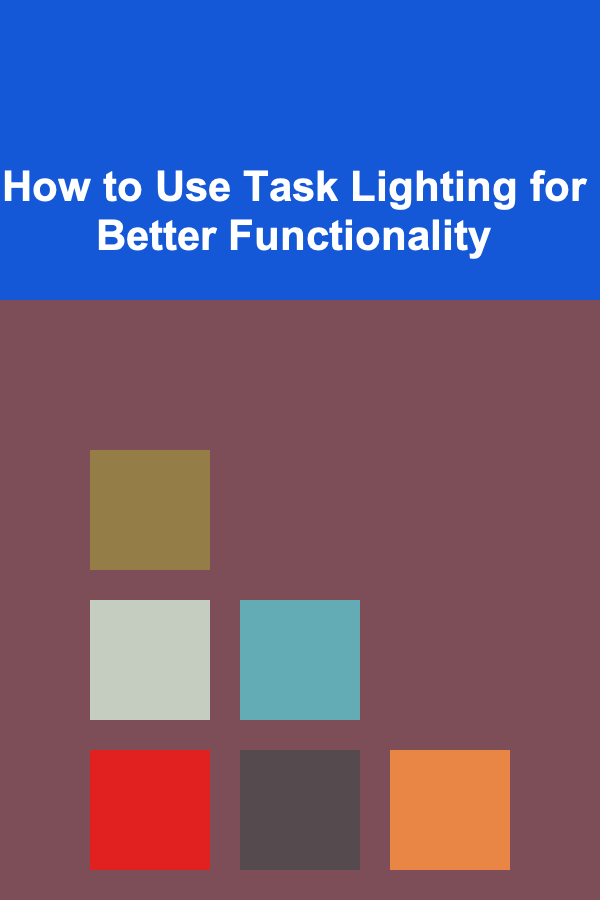
How to Use Task Lighting for Better Functionality
ebook include PDF & Audio bundle (Micro Guide)
$12.99$8.99
Limited Time Offer! Order within the next:

In an age where functionality and design must coexist harmoniously, task lighting emerges as a vital element in creating versatile spaces that cater to specific needs. Whether you are reading a book, working on a craft project, or cooking dinner, proper lighting can enhance your ability to perform tasks efficiently while adding aesthetic appeal to your environment. This article will explore what task lighting is, its importance, the various types available, how to select the right fixtures, and practical applications across different settings.
Understanding Task Lighting
1. Definition of Task Lighting
Task lighting refers to a type of lighting that is specifically designated to illuminate areas where focused activities occur. Unlike ambient lighting, which provides general illumination for an entire space, task lighting offers targeted illumination to facilitate detailed work, enhancing visibility and reducing eye strain.
2. Importance of Task Lighting
The significance of task lighting cannot be overstated. Its primary functions include:
- Enhancing Visibility: Adequate task lighting allows individuals to see clearly, reducing shadows and glare during focused activities.
- Promoting Efficiency: Well-lit workspaces can improve concentration and productivity by providing the necessary light for intricate tasks.
- Preventing Eye Strain: Sufficient lighting reduces the likelihood of eye fatigue associated with working in poorly lit conditions.
- Creating Ambiance: Task lighting can also contribute to the overall aesthetic of a room, allowing for creativity in design.
Types of Task Lighting
Understanding the various types of task lighting is crucial for selecting the right fixtures for your specific needs. Here are some common options:
1. Desk Lamps
A. Characteristics
Desk lamps are portable fixtures designed for desktop use. They often come with adjustable arms and shades, allowing users to direct light precisely where it's needed.
B. Applications
Ideal for studying, reading, or performing detailed work, desk lamps can easily be positioned based on individual needs, making them versatile additions to home offices or study areas.
2. Floor Lamps
A. Characteristics
Floor lamps provide overhead lighting without requiring installation. Many models offer adjustable brightness levels and pivotable heads.
B. Applications
These lamps are excellent for reading nooks, living rooms, or any area where seating arrangements benefit from focused lighting. They can brighten dark corners while still serving as decorative elements.
3. Wall Sconces
A. Characteristics
Wall sconces are mounted fixtures that provide a blend of decorative and functional lighting. They can be directed upwards or downwards, depending on the design.
B. Applications
Perfect for hallways, entryways, or beside beds, wall sconces can illuminate specific areas without taking up valuable floor space, creating a clean and streamlined look.
4. Under-Cabinet Lighting
A. Characteristics
Installed beneath cabinets, these fixtures provide targeted illumination without occupying visible space.
B. Applications
Commonly used in kitchens and workspaces, under-cabinet lighting enhances visibility when preparing food or engaging in other tasks.
5. Track Lighting
A. Characteristics
Track lighting consists of multiple fixtures attached to a single track, allowing users to adjust the direction of each light.
B. Applications
Track lighting is ideal for art studios, galleries, or any space where flexibility in lighting direction is required. It can highlight specific areas or artworks.
6. Pendant Lights
A. Characteristics
Hanging from the ceiling, pendant lights come in various styles and sizes, often serving both decorative and functional purposes.
B. Applications
Pendant lights are popular above kitchen islands, dining tables, or workspaces, providing focused light while also contributing to the decor of the room.
Selecting the Right Task Lighting
Choosing the appropriate task lighting involves considering several factors to ensure optimal functionality and style. Here are key aspects to keep in mind:
1. Purpose and Activity
Identify the primary activities that will take place in the space. For example, if the area is used primarily for reading, opt for adjustable desk lamps or floor lamps with good wattage and color temperature to provide sufficient illumination.
2. Brightness Level
Brightness is measured in lumens. The higher the lumen count, the brighter the light. Consider the following guidelines:
- Reading/Studying: Aim for around 300-600 lumens per lamp.
- Craft Work: Depending on the intricacy of the task, 500-1000 lumens may be beneficial.
- Cooking: 500-800 lumens below cabinets or work surfaces can enhance visibility.
3. Color Temperature
Color temperature affects mood and clarity. Measured in Kelvins (K), it typically falls into three categories:
- Warm White (2700K - 3000K): Creates a cozy atmosphere but may not be suitable for detailed tasks.
- Neutral White (3500K - 4100K): Provides clarity and balance, making it ideal for offices.
- Cool White (5000K - 6500K): Mimics daylight; excellent for precision tasks like crafting or technical work.
4. Adjustability
Consider whether you need adjustable features such as movable arms or dimmers. Adjustable task lighting allows for customization based on the activity and time of day, enhancing functionality.
5. Design and Style
Choose task lighting that complements the aesthetics of the space. Whether modern, traditional, or eclectic, the design should harmonize with existing decor while meeting functional needs.
Practical Applications of Task Lighting
Now that we understand the types and selection criteria, let's explore practical applications of task lighting across various settings.
1. Home Office
A. Desk Setup
In a home office, adequate task lighting is essential for productivity. Place a desk lamp with adjustable brightness at eye level to minimize glare from screens and create a comfortable workspace.
B. Additional Lighting
Consider adding floor lamps or wall sconces to illuminate corners or provide ambient light alongside task lighting. Layered lighting can help maintain focus during long hours of work.
2. Kitchen
A. Cooking Preparation
Install under-cabinet lighting to enhance visibility on countertops while chopping vegetables or following recipes. This ensures safety and efficiency during food preparation.
B. Dining Area
Pendant lights above the dining table can serve dual purposes---providing task lighting for meals and enhancing the dining experience. Opt for dimmable pendants to adjust the ambiance according to the occasion.
3. Living Room
A. Reading Corners
Create a cozy reading nook with a combination of floor lamps and table lamps. Position the lighting to reduce shadows and create a warm atmosphere conducive to relaxation.
B. Entertainment Areas
Use adjustable track lighting to highlight artwork or architectural features. Incorporating accent lighting adds depth and visual interest to the room.
4. Bedroom
A. Bedside Lighting
Invest in bedside lamps or wall-mounted sconces that provide sufficient light for nighttime reading while being soft enough not to disrupt sleep patterns. Dimmable options are particularly useful for winding down.
B. Dressing Spaces
In areas designated for dressing or grooming, use bright, flattering task lighting. Consider wall-mounted vanity lights that provide even illumination for applying makeup or styling hair.
5. Craft or Hobby Space
A. Detailed Workstations
For spaces designed for crafting, art, or hobbies, prioritize bright, focused lighting. Desk lamps with magnifying glasses can aid in intricate tasks, preventing eye strain and enhancing accuracy.
B. General Setup
Utilize flexible track lighting to spotlight different areas based on the specific task being performed. This adaptability fosters a well-organized and efficient workspace.
Energy Efficiency Considerations
Selecting energy-efficient lighting options not only benefits the environment but also reduces utility bills. Here are some tips:
1. LED Bulbs
LED bulbs consume significantly less energy than traditional incandescent or fluorescent bulbs, offering longer lifespans and lower heat output. This makes them ideal for task lighting applications.
2. Smart Lighting Solutions
Smart bulbs allow users to control brightness and color temperature through smartphone apps or voice commands. These systems can adapt to changing needs and schedules, increasing energy efficiency.
3. Timers and Sensors
Using timers or motion sensors can further optimize energy usage. Automating task lighting ensures lights are only on when needed, preventing unnecessary waste.
Integrating Task Lighting with Other Light Sources
While task lighting is critical for focused activities, integrating it with other light sources enhances overall functionality and aesthetics. Here's how:
1. Layered Lighting Approach
Combine ambient, task, and accent lighting to achieve balance. Ambient lighting provides general illumination, while task lighting focuses on specific areas, and accent lighting highlights decor.
2. Dimmer Switches
Installation of dimmers allows for adjusting brightness levels based on the time of day or activity. This flexibility creates an adaptable environment suitable for various functions.
3. Color Coordination
Coordinating color temperatures among different light sources can create a cohesive look. For instance, maintaining a warm white tone throughout the room promotes comfort and continuity.
4. Natural Light Considerations
Where possible, complement task lighting with natural light sources. Strategically placing mirrors can reflect sunlight into darker corners, reducing the need for artificial lighting during the day.
Troubleshooting Common Task Lighting Issues
Even with careful planning, issues may arise with task lighting. Here are solutions to common problems:
1. Insufficient Light Levels
If task lighting feels inadequate, consider upgrading to bulbs with higher lumen outputs or adding additional fixtures to the space.
2. Glare and Shadows
To combat glare, position task lighting away from reflective surfaces. Using lampshades can diffuse light and reduce harshness. Regularly adjust the height and angle of fixtures to minimize distracting shadows.
3. Overheating
If task lighting becomes too hot, switch to cooler LED options or ensure proper ventilation around fixtures. Avoid covering bulbs to prevent overheating.
4. Flickering Lights
Flickering can signal an issue with the bulb or fixture. Ensure bulbs are securely installed, and replace any damaged components. If problems persist, consult an electrician.
Conclusion
Task lighting is fundamental for improving functionality within various spaces, enhancing both productivity and comfort. By understanding the types of task lighting available, selecting appropriate fixtures, and implementing effective strategies, individuals can create environments tailored to their needs.
Whether in a home office, kitchen, or craft room, the right lighting can make all the difference in promoting efficiency and enjoyment of everyday tasks. By embracing the principles outlined in this article, you can harness the power of task lighting to transform your living spaces into functional and aesthetically pleasing areas. With thoughtful consideration and planning, you can illuminate your world in a way that not only meets your practical needs but also elevates your overall experience.

Becoming a Successful Database Administrator: Essential Skills for Data Security and Integrity
Read More
How to Build a Profitable Business Using Deep Learning
Read More
How to Build a Stylish Storage Bench for Extra Seating and Storage
Read More
How to Create a Holiday Scavenger Hunt with Decorations for Kids
Read More
How to Incorporate Task Lighting into Your Home's Design
Read More
How to Use Furniture Layouts to Improve Traffic Flow During Showings
Read MoreOther Products

Becoming a Successful Database Administrator: Essential Skills for Data Security and Integrity
Read More
How to Build a Profitable Business Using Deep Learning
Read More
How to Build a Stylish Storage Bench for Extra Seating and Storage
Read More
How to Create a Holiday Scavenger Hunt with Decorations for Kids
Read More
How to Incorporate Task Lighting into Your Home's Design
Read More